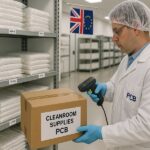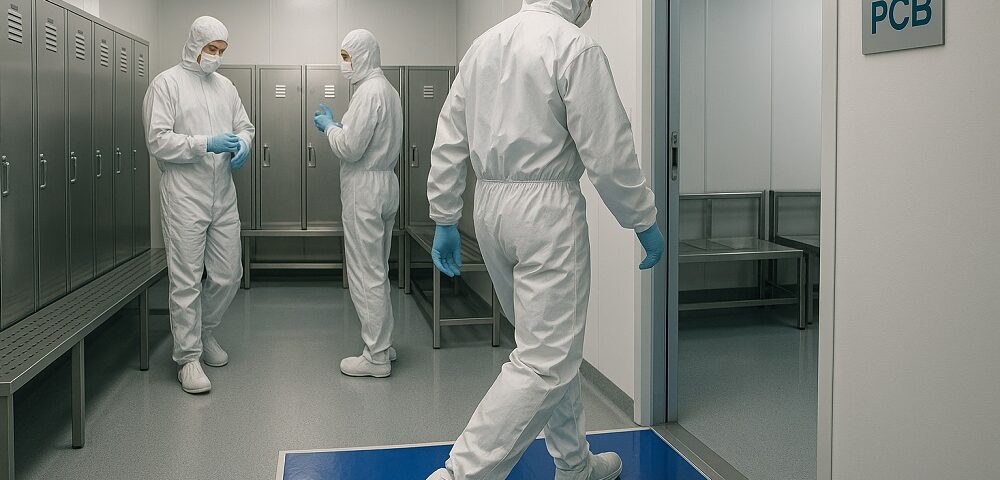
UK-EU Cleanroom Sales Support
July 8, 2025Top Cleanroom Contamination Sources and How to Eliminate Them
Maintaining contamination control inside a cleanroom is essential. In industries such as pharmaceuticals, biotechnology, aerospace and semiconductor manufacturing, even microscopic particles can compromise product quality, disrupt research or result in failed compliance inspections.
Contaminants originate from multiple sources: people, packaging, air systems, equipment surfaces or materials in transit. Understanding where contamination starts and how to prevent it is critical to maintain cleanroom classification and operational integrity.
This article outlines the most common sources of contamination and provides clear strategies for reducing risk using ISO-compliant supplies and cleanroom best practices.
Pristine Clean Bags® Helps You Minimize Cleanroom Contamination
Pristine Clean Bags® supplies cleanroom packaging and contamination control products trusted by companies across pharmaceuticals, biotechnology, aerospace, semiconductor manufacturing and other high-precision industries. Our product range includes ISO-compliant cleanroom bags, moisture-barrier film, tubing, cleanroom wipes, sticky mats and more.
With over 40 years of experience and ISO certification, we help organizations maintain strict cleanliness standards by providing consistent, reliable cleanroom packaging supplies that meet FDA and EU compliance requirements.
For technical questions or to request a quote, contact us at (410) 581-0303 or info@pristinecleanbags.com.
Human Activity and Behavior
People are one of the most common sources of cleanroom contamination. Even when fully gowned, human bodies naturally shed skin cells, hair and microbes. Movement, talking and improper handling of materials can release airborne particles that compromise cleanroom integrity.
Key contamination risks from personnel include:
- Skin flakes, oils and hair
- Loose fibers from improperly worn garments
- Talking, coughing or sneezing
- Incorrect gowning or glove procedures
- Rapid or excessive movement that stirs up particulates
How to reduce contamination caused by human activity:
- Use cleanroom sticky mats at all entry and transition points to trap particles from footwear and cart wheels
- Establish strict gowning procedures in designated gowning areas
- Require low-lint, ISO-compliant garments and gloves
- Limit unnecessary movement and enforce proper behavior protocols (no leaning on surfaces, no sudden movements)
- Train all personnel regularly on contamination control best practices
Improper or Non-Compliant Packaging
Cleanroom packaging that isn’t designed for controlled environments can introduce significant contamination risks. Bags, tubing and films that shed particles, attract static or lack proper sealing can compromise sensitive materials and violate ISO class requirements.
Common packaging-related contamination issues:
- Using non-cleanroom-grade plastic bags that release particulates
- Relying on materials that generate static electricity
- Introducing outer packaging (like cardboard) into clean zones
- Reusing bags that have been exposed to uncontrolled environments
How to reduce contamination from packaging:
- Choose packaging specifically manufactured for cleanroom use, such as LDPE bags, HDPE or nylon cleanroom bags
- Use ESD and static-shielding bags when required for electronics or ESD-sensitive applications
- Follow double-bagging protocols when transferring materials into clean areas
- Avoid bringing outer corrugated boxes or contaminated packaging into ISO-classified spaces
- Inspect packaging for damage, residue or defects before use
Proper packaging is a frontline defense against contamination.
Surfaces and Equipment Residue
Work surfaces, carts, tools and fixtures can all become hidden sources of contamination if not cleaned regularly using the right materials and techniques. Particles, chemical residue, and static buildup can accumulate on surfaces and transfer to cleanroom products during handling.
Common surface-related contamination issues:
- Dust or lint on worktables and benches
- Residue from adhesives, packaging or chemicals
- Dirty wheels on carts and equipment
- Improper cleaning with non-compliant materials
How to reduce contamination from surfaces and equipment:
- Wipe all surfaces frequently using cleanroom-grade wipes
- Use low-lint, pre-wetted wipes with isopropyl alcohol (IPA) or DI water for residue removal
- Follow proper wiping techniques – one-directional strokes, clean side per pass, and proper folding
- Clean and inspect carts and rolling equipment before entering controlled areas
- Avoid general-use rags, towels or sprays that may leave fibers or residues behind
Cleanroom maintenance isn’t only about air quality or packaging, it depends on what’s directly under your hands, tools and materials every day.
Airborne Particles
Airborne contamination is one of the most difficult threats to control in a cleanroom environment. Microscopic particles can originate from outside air, people, surfaces, packaging or materials in transit. Without effective filtration and airflow management, these particles can remain suspended and settle onto critical workspaces.
Common airborne contamination sources include:
- Inadequate or poorly maintained HEPA/ULPA filtration systems
- High foot traffic or excessive movement inside the cleanroom
- Improper airlock or gowning procedures
- Gaps in pressurization or ventilation design
How to reduce airborne contamination:
- Maintain and routinely inspect your cleanroom’s HVAC and filtration systems according to ISO requirements
- Ensure proper room pressurization to minimize air exchange from uncontrolled areas
- Use airlocks, ante rooms and staging areas to reduce direct exposure
- Limit personnel entry and enforce gowning protocols in transition zones
- Review your cleanroom’s HVAC design against your ISO classification needs (for more info read HVAC Design for Cleanrooms).
When airborne contamination is managed properly, it helps protect not only your products but also your people, processes, and long-term compliance.
Entry & Transition Points
Cleanrooms depend on controlled access, but every doorway, hallway and material transfer area presents a risk. Entry and transition points are hotspots for contamination due to foot traffic, wheeled carts, improper gowning, and unclean materials moving between clean and non-clean zones.
Common contamination risks in transition areas:
- Shoes or wheels carrying particles from uncontrolled spaces
- Incomplete gowning between rooms of different ISO classes
- Materials or packaging crossing zones without proper prep
- Poorly maintained staging or gowning areas
How to reduce contamination at entry points:
- Place cleanroom sticky mats at all major doorways, airlocks and gowning areas to trap debris
- Use dedicated staging areas for materials prior to cleanroom entry
- Follow a unidirectional workflow with increasing cleanliness (e.g., gowning → ante room → cleanroom)
- Train staff on correct procedures for gowning and material handling between zones
- Post signage and floor markings to guide movement and reduce cross-contamination
Every entry point is a potential breach. With the right supplies and protocols in place, you can turn these high-risk zones into strong contamination barriers.
Poor Supply Storage & Handling
Even if your cleanroom supplies are ISO-compliant, how they’re stored and handled before use can affect their performance. Improper storage introduces particles, moisture or microbial contamination undermining even the best cleanroom practices.
Common storage and handling issues:
- Storing cleanroom bags, wipes or mats in uncontrolled environments
- Allowing supplies to contact dirty shelves, floors or packaging
- Opening products outside designated prep areas
- Failing to monitor storage conditions like temperature or humidity
How to reduce contamination from storage and handling:
- Store supplies in enclosed cabinets, clean shelving unit or cleanroom wipe dispensers
- Keep items in original packaging until ready for use inside the cleanroom
- Avoid stacking supplies on the floor or in areas exposed to airflow or personnel traffic
- Use dual-bagged items when possible and disinfect outer layers before entry
- Monitor temperature and humidity to protect packaging integrity over time
Even the most advanced cleanroom materials lose effectiveness if they’re mishandled before use. Proper storage keeps your contamination control strategy intact from start to finish.
Final Thoughts
Contamination control in cleanrooms starts with understanding where the risks come from and taking active steps to eliminate them. From human behavior and improper packaging to surface residue and airflow issues, every factor plays a role in maintaining your ISO classification and product integrity.
The good news is that most contamination sources can be managed with the right combination of training, layout and compliant supplies. Cleanroom sticky mats, ISO-rated bags, low-lint wipes and proper storage protocols are simple yet powerful tools for building a contamination-resistant workflow.
FAQ
What are viable vs. non-viable contaminants in cleanrooms?
Viable contaminants are living organisms such as bacteria, fungi or viruses that can reproduce and spread in clean environments. Non-viable contaminants include dust, fibers, skin flakes and other particulates that don’t carry life but still compromise cleanliness standards. Both types must be controlled in regulated cleanrooms.
Can cardboard be used inside a cleanroom?
No. Cardboard is a major contamination risk in cleanrooms due to its fibrous structure and tendency to shed particles. It can also absorb moisture and harbor microbes. All materials introduced into clean zones should be non-shedding, cleanroom-compatible and disinfected if necessary.
Do cleanroom supplies have expiration dates?
Yes. Many cleanroom supplies, including wipes, packaging and mats, have expiration dates or manufacturer-recommended storage durations. Always check product labels and store items in clean, controlled conditions to prevent degradation before use.
What is the role of static control in contamination prevention?
Static electricity can attract and retain particles, which then transfer onto clean surfaces or products. In environments handling sensitive electronics or powders, anti-static packaging, ESD-safe wipes and grounded equipment are essential to prevent particle attraction and electrostatic discharge.
How often should contamination control protocols be reviewed?
Contamination control protocols should be reviewed at least annually or whenever there’s a change in cleanroom layout, processes, equipment or personnel. Regular audits, retraining sessions, and SOP updates help maintain compliance and minimize risk over time.

